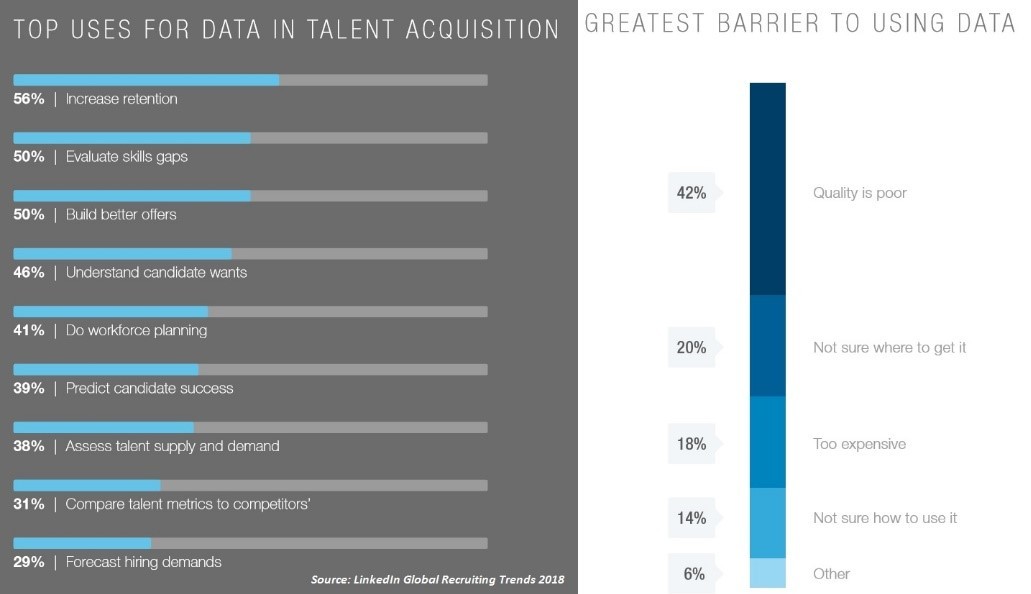How to Use Big Data to Navigate a Tight Labor Market

Leveraging big data can help with the challenges presented by today's U.S. labor market.
The U.S. labor market presents unprecedented challenges in talent recruitment and retention. With record-low unemployment, per the latest Bureau of Labor Statistics findings, talent acquisition professionals are finding talent attraction to be a more difficult challenge that requires new ways of thinking.
Additionally, with voluntary turnover having an inverse correlation to unemployment, talent management professionals have a similarly sophisticated task to retain employees.
Both of these HR groups must find a way to deal with new talent marketplace dynamics. Big data is a powerful tool that can help.
As luck would have it, the marketplace is becoming increasingly complex while big data and analytics are becoming more intricate. The challenge and the solution are developing at the same pace.
According to LinkedIn's Global Recruiting Trends for 2018, 50 percent of HR professionals consider data very important in shaping recruiting and hiring, yet just 18 percent have adopted the use of data. Fifty-six percent of respondents believe data can help increase retention and 39 percent believe data can help predict candidate success. Yet, barriers to using data are often cited — from a perceived poor quality of data to lack of knowledge about where to get it and how to use it.
According to a Human Capital Institute survey, as much as 80 percent of HR practitioners say their business leaders still rely on "gut feeling" to make talent decisions. How many leaders would admit to making inventory purchasing decisions or setting a sales plan target based on "gut feeling?" Yet, organizational talent is likely a bigger asset than its inventory.
So how can data analytics help talent acquisition and talent management professionals succeed in this marketplace? The solution can be found in three distinct yet equally important data sets — and the application of them in conjunction with each other — to build a comprehensive picture of the talent landscape and enable data-driven hiring decisions.
1. Internal Talent Acquisition Data
Understanding how to capture and use internal data can help improve the recruitment process and hiring decisions from talent attraction (employment brand and review scores), to process effectiveness (channel effectiveness analytics, time-to-fill drivers, candidate-to-hire conversion ratios and offer declines), to candidate profile (demographics, education, compensation, experience matching and more).
For example, channel effectiveness analytics can help direct advertising dollars and indicate candidate profiles that are a good fit. Understanding conversion ratios can help identify issues in the process and where opportunities may exist. Looking at sub-cycle times can offer a better picture than overall time-to-fill, since it shows specifically where improvements can be made. Offer-decline analysis can provide insight into the reasons a preferred candidate chooses not to join the organization.
2. Internal Talent Management Data
Looking at data analytics can help improve your understanding of employee retention. How do training and development, educational background and organizational design impact performance? How do compensation, performance and commute distance impact retention? What other drivers impact performance and retention?
These are just some of the key business questions talent analytics can answer. Some of this data requires thorough analysis of HR, compensation and performance metrics, while others can be easier to obtain directly through stay surveys and exit surveys.
3. External Market Data
External data can tell an interesting story. Review competitive activity, compensation and benefits benchmarks, policies that reflect industry realities (from telecommuting to flex-time), labor supply and demand, talent demographics and so on. These are critical in making talent acquisition and talent management effective in a competitive marketplace.
For example, the next time you backfill a role, consider what the market (or your competition) would pay for the skill set you seek instead of the role's internal comp range or former occupant's salary.
Tying Everything Together
It is when these three data sets are used in conjunction that amazing things can start to happen. Hiring choices can be made that focus on long-term employee retention and maximizing performance while reflecting marketplace conditions. Employee management decisions can be made with an emphasis on organizational effectiveness and employee retention. And data can be used to validate the quality of these decisions and make course adjustments as needed.
Insights from existing employees and talent management should be included in talent acquisition strategy. This, in turn, can be used to design sourcing strategies targeting active candidates where the right hires can lead to improved performance and retention. Feeding this data back to the beginning of the process is critical to having an effective and cohesive talent strategy.




